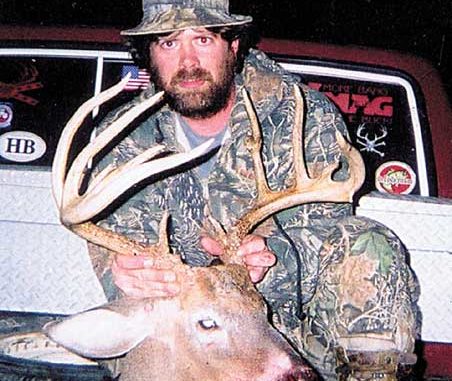
An eastern Guilford trophy hunter is like B’rer Rabbit — he’s happiest when he’s in the briar patch.
Eastern Guilford County resident Bill Martin visited the March 2008 Dixie Deer Classic to enter one of his recent trophy white-tail heads in the event’s Big Buck Contest.
“I thought I’d get it scored, just to see how it’d stack up,” he said. “I didn’t expect to win anything.”
Martin also didn’t expect one of the fabled deer hunters in the world, Larry Weishuhn of Texas, to be stopped cold after seeing the Tar Heel hunter’s monster — an awesome eight-point buck with156 1/8-inches of antlers — and talking to the truck driver. Martin killed the buck with his muzzle-loader near Halifax, Va., during 2007.
“I guess (Weishuhn) was impressed,” Martin said. “He asked me to come hunt with him (in Texas).”
It’s a good thing Weishuhn didn’t drive to Martin’s home near Lake MacIntosh in eastern Guilford County. The Texan might have forsaken hunting the Lone Star state’s whitetails. Martin’s trailer has a collection of wall-hangers any hunter would be proud to possess.
“They’re mostly deer I killed around here,” said Martin, 40, a Wilmington native who has lived in Guilford and Alamance County most of his life.
Surprisingly enough, Martin downed only one of a dozen or so of his magnificent bucks with a modern rifle.
“I’ve killed so many deer it’s just not that much of a challenge to shoot one with a rifle anymore,” he said. “The older I get, the more I like the challenge of bow hunting or using a muzzle-loader.”
Martin said he killed most of his deer within 30 yards of his tree stands.
“I don’t need something that will shoot 200 yards flat as a string,” he said. “I usually don’t hunt such places. I like to get in as thick a place as possible, right on the edge of their bedding areas.”
Martin hunts Virginia each year because that state’s muzzle-loader season usually opens a week earlier than in North Carolina.
He killed his first buck in “1986 or ’87” when he was a teen, hunting between Snow Camp (Alamance) and Siler City (Randolph County).
“I used an old borrowed .303 Enfield rifle,” he said.
Later he killed several other deer with modern rifles, but downing deer became so routine he turned to archery and muzzle-loading equipment.
Outside his annual trip to Halifax County, these days he doesn’t venture far, going to local farms where he has permission to hunt.
“I don’t like to bow hunt when it’s so hot in September,” he said. “But I do a lot of pre-season scouting; I just get out and walk, meander around looking for (deer) sign.”
His favorite sign indicators are travel corridors between thickets that serve as bedding areas and halfway up the sides of hardwood ridges.
He doesn’t hunt field edges, but he pays attention to does in fields.
“As a rule, your biggest bucks aren’t going to walk out in an open field in the day time,” he said. “They didn’t get big by being dumb.
“You might see (a trophy deer) in the open during the rut (in November), but that’s about the only time. Other than that, they’re walking out in the open at night. Only the does will be in fields in the daytime.”
Patterns are important to successful deer hunting, just like fishing,” said Martin, an accomplished big catfish angler. His key pattern for November is to look for concentrations of female deer.
“You can pattern younger bucks or does (at agricultural fields), then set (up a stand) back in the woods and catch the bigger deer before the light runs out,” he said. “But if you put your stand up next to a field, you won’t see much but does and real young bucks — except for one time.”
That would be the mating season or rut. Most serious trophy hunters know, as Martin siad, patterning a buck is impossible during the “peak” of the rut, which usually occurs at central North Carolina from the end of October through the first two weeks of November.
“Bucks will be moving 24/7 (during the rut), looking for does,” Martin said. “It probably won’t do you any good to go where you saw a buck during bow season and didn’t get a shot, but a lot of people think if they hunt the same stand, they’ll see him during the rut.
“Most of the time, the deer you saw in September and October will be some other place, and you’ll be looking at an entirely different set of deer that’s moved into an area.”
Martin said most of his shots are in the 25-yard range.
“All of the trophies on my wall, except one, I shot 50 yards or closer, some as close as 8 or 10 yards,” he said.
Another advantage of hunting closely, Martin said, is he can get a better view of a buck’s headgear. That’s important to him because now he only wants to shoot mature bucks.
“A lot of people shoot 16-inch (wide outside spread of antlers) bucks, but I won’t do it,” he said. “I’ve have let a bunch of small bucks walk.”
Martin believes in stockpiling bucks, letting them live to grow more impressive racks.
“People who shoot small bucks tell me, ‘If you don’t shoot him, he won’t make it through a year anyway,’ ” Martin said. “I say ‘Good gracious; if you kill him now, it’s for certain there’s no way he’s gonna grow up.’ Just look at my wall; there’s the proof. Most of those deer I saw when they were younger, and I let ’em walk.”
Martin said he also harvests plenty of does, which helps keep herds in balance at places where he hunts.
“If I don’t see a buck after a month and a half, I’ll start shooting does,” he said. “At one farm, I counted 12 does in a bunch several times, but no bucks. So I started working on (the does). Then the week after Christmas, at the same place, I started seeing bigger bucks and killed one that was 21 inches wide (inside spread).”
Martin insisted a big group of does will “run off” bucks in the area.
“With lots of does around, the bucks will stay in the deep woods, and you won’t see ’em,” he said. “You can’t pattern bucks that have a lot of does living in the same area.”
Martin’s theory is by killing does, large bucks are forced closer to fields to check out estrous females because the bucks aren’t encountering hot does at their daytime hideaways. But does like to eat and will come to agricultural fields, drawing bucks along travel routes where Martin sets up his bow or muzzle-loader stands.
The veteran white-tail hunter also prefers mobility in setting up tree stands. He never hunts one place for long.
“I like being mobile,” he said. “Deer, especially big bucks, will get wise to a (permanent) stand.”
Martin, who also started using trail cameras a year ago to help him scout for big antlers, uses climbing stands exclusively, strapping them on his back and walking to a site the morning of a hunt. .
“I like hunting up high,” he said. “You won’t catch me in a stand 12 feet off the ground; I’ll be at least 20-feet up.”
Martin’s high-road approach is dictated by a deer’s acute sense of smell. He likes his stands to be elevated enough so errant breezes can’t carry his scent to a whitetail’s nostrils.
“I don’t use any deer lure (scents),” he said, “but I’m real careful to use unscented soaps, and I wash my (hunting) clothes in non-scented detergent.”
Martin uses a face mask only when he’s bow hunting because bow shots need be close, and deer often detect the movements of a hunter pulling back a bow string.
“If you don’t wear a face mask, deer can spot your face,” he said. “Big tip — never make eye contact with a deer that’s looking at you; they’ll peg you in a minute if you look into their eyes.
“I also try to match camouflage clothing to the seasons. I like Predator camou (clothing) in November and December. I like its regular-stick break-up pattern; it’s got sharp lines that kinda looks like lightning bolts, only wider.
“It’s OK to wear normal green and brown camo patterns when the leaves are on the trees. If a deer sees you, you’ll look like a big squirrel nest. But because Predator camou is white with gray streaks, it looks like sky and clouds. If a deer looks up, you’re almost invisible. I’ve had friends walk by, and they never saw me sitting in a tree with no leaves.”
Martin also wears rubber knee boots instead of scent-catching leather boots and stuffs his pants legs into them. If he walks across a frost- or dew-covered field or his lower legs touch bushes or long-stemmed grasses, the smell of rubber apparently mimics the scent of auto tires — which deer are accustomed to sensing.
“When I put up a stand, I’m also aware of the wind (direction),” he said. “You don’t want to hang a stand where the wind blows from you toward a bedding area. Deer can smell you when you walk to a tree before you get up in it.”
Scent awareness also is why Martin doesn’t like to hunt ravines or swamp bottoms because scent collects at such places. His favorite stands are on the sides of hardwood ridges near bedding areas.
“If I’m in a hilly area, I want to be high enough I can see the ridge top and the bottom,” he said.
Deer often bed down in pine thickets on the sides of hills or in cutovers. In hilly areas, their trails usually run parallel to the bottoms and tops of ridges.
“The best (stand) situation is a hardwood ridge that has acorns,” Martin said. “That way (deer) can get up and walk a short way to find food.”
Cold weather is another reason to hunt ridges, Martin said, because deer like to bed down at such spots facing east.
“It’s the first place the sun hits in the morning,” he said. “They just want to get warm as soon as possible.”
September and October also are good times for hunting such spots because that’s when acorns drop. During November and December, after the deer have eaten most of the acorns, Martin places stands near travel corridors between bedding areas and fields with unharvested or scattered excess crops.
Of course the best time to hunt a November deer is the peak of the rut period when bucks throw caution to the wind and literally become stupid in the pursuit of girlfriends, (as are many of their human counterparts).
“I love the rut,” he said. “You might not see a buck you’ve seen before, but if you can stay in your stand all day, more than likely you’ll see at least one good buck.”
Martin’s favorite days for deer hunting this month include just before low or high pressure systems sweep through, and he also pays close attention to moon phases.
“I base my hunting stuff on fishing tactics; they’re alike,” he said. “When you’ve got certain pressures coming, deer will move.
“If there’s a full moon (the previous night), I’ll concentrate hunting from 9 a.m. to evening. Deer are like people. If (the moon) is full, they travel. On a dark or quarter moon, deer will move early and late.”
Even though patterning individual bucks is impossible during the rut, hunters still shouldn’t abandon places where they’ve seen bucks or signs of bucks, Martin said.
“Look for does,” he said. “If the does are there, a buck will be coming at some point.
“(Hunting bucks) is like playing cards. People will say to me ‘Why are you hunting my spot; I ain’t seen no bucks there?’ and I’ll say ‘You gotta play what’s dealt you.’ You might kill the smallest buck — or you might kill the biggest buck of your life.”
Serious white-tail hunters might consider Martin’s advice. He’s got a half-dozen 160-class buck racks hanging on his wall and several more in the 140 to 150 range. Not only that he’s won three consecutive Guilford Wildlife Club’s big-buck contests ( 2002-03-04).
“There’s no secret to it,” he said. “Just knowing the woods, where the deer travel, looking for signs like rub trees and checking out tracks are keys to killing big deer.”
Of course, success also is tied to one’s dedication and focus.
“You’ve got to take the time to be out there,” Martin said. “Nobody’s ever killed a deer sitting on the couch, looking at TV.”

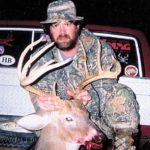
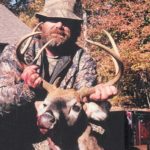
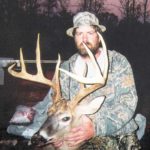
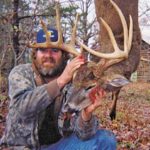
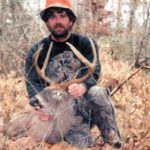
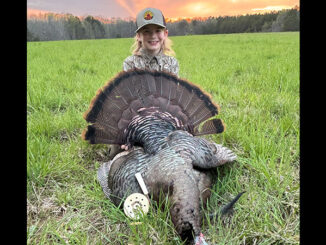



Be the first to comment